Activity 7: DNA
Topic: DNA is genetic material that is found in every cell of the body and it also makes you one-of-a-kind. Because DNA is found in every cell, when evidence is left behind by people and animals, we can extract DNA from that evidence to identify who left it, just like crime scene investigators.
Time: This lesson should take approximately 45-60 minutes to complete.
Learning Outcomes:
At the end of this activity, youth should be able to…
- Explain how DNA is passed down from generations, while still making you unique.
- Explore ways in which DNA information can be used.
Background Information for Facilitator:
DNA stands for deoxyribonucleic acid. Your DNA is unique to you and is different from every other person in the world (unless you’re an identical twin). DNA is in every cell in our body, we have around 10 trillion cells. DNA tells each cell what it is (liver cell, skin cell, etc.) and what it’s supposed to do (your job is __). DNA stays the same throughout your entire life, it doesn’t change or grow as you grow older.
Crime scene investigators can extract DNA from blood, urine, and saliva samples. Investigators can then match the DNA they extracted to a library of DNA samples they have. This helps them catch suspects of crimes. DNA is also inherited, meaning that it gets passed down from generation to generation. In other words, you have some DNA from your father and some from your mother, making you unique. If you have a sibling, they will share some of your DNA because it was passed from the parents as well, but it may not be exactly the same (different eye color, hair color, heights, they can roll their tongue and you can’t, etc.).
Note for Facilitator: Allergy warning: Strawberries are required to perform the experiment in the ‘elaborate’ phase.
Materials:
- Whiteboard
- Pony beads – 4 different colors
- Inheritance bead template

For DNA extraction experiment:
- Strawberries
- Dish detergent
- Salt
- Water
- Plastic cups
- Coffee filters
- Rubbing alcohol
- Coffee stirrer
- Measuring tools
- Extraction observation sheet
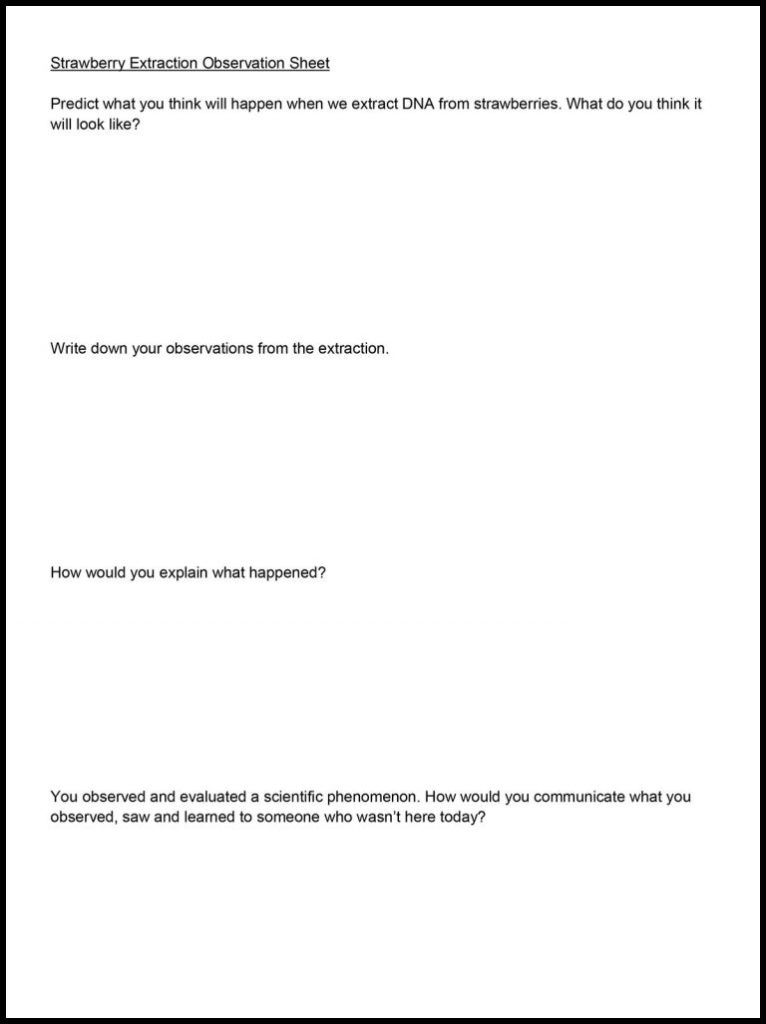
For Extension option:
- Plain white paper
- Pencil
- Colored pencils
Vocabulary:
- DNA (deoxyribonucleic acid) = material that is present in all living organisms, which is present in every cell. It communicates to the cells what they are and what their role in the body is. It contains all the genetic information needed to make and maintain us.
- Inheritance = something that gets passed on from generation to generation
- Dominance = because individuals get two versions of each gene (one from each parent), if they are different only one is expressed, which is the dominant gene. The other version of the gene is recessive, meaning is gets masked (or doesn’t get expressed)
- Generation = the offspring that are the same stage of descent from a common ancestor (a mother and daughter represent two generations because they are at different stages of descent, whereas your mother and all her siblings are one generation).
- Offspring = young (inclusive of both people and animals, so it includes children, fawn, cubs, etc.).
- Traits/physical characteristics = feature of an organism
- Genes = a unit of DNA that controls the development of a trait(s) and is responsible for the passing of genetic information from parent to offspring.
Methods:
Engage
Ask youth to help you complete a survey about human characteristics.
-
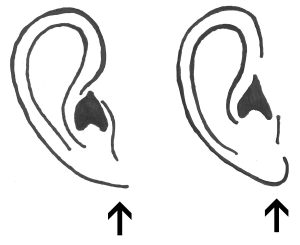
Drawing: Example of an attached earlobe (left) and a detached earlobe (right) – Drawing, Jessy Brainerd Survey the youth on their earlobes, specifically if they are attached or unattached.
- Detached earlobes (earlobes with a little hang) are the dominant trait (more common), making attached earlobes recessive.
- Record numbers (on Google Slide, whiteboard, etc.).
- Survey the youth whether they can roll their tongues (into a hotdog shape).
- Record numbers. Tongue rolling is dominant, the non-rolled tongue is recessive.
- Survey the youth on their hairline. Do you have a straight hairline or does your hairline form a point at the center of your forehand (widow’s peak)?
- Record numbers. Only 35% of the world’s population has a widow’s peak (even though it is the dominant trait).
- “What do you think determines these characteristics?” “How did you develop that inference from what you just saw?”
Explore
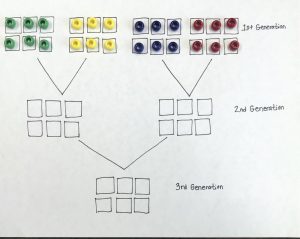 To understand better what all of this means, we’re going to use beads to model inheritance. Notice that the template uses “generation” to label the different stages of descent. Review this vocabulary with youth.
To understand better what all of this means, we’re going to use beads to model inheritance. Notice that the template uses “generation” to label the different stages of descent. Review this vocabulary with youth.
- Distribute 6 of each color bead to every youth.
- Using pony beads, layout 6 of the same color represent one individual within one set of individuals in the first generation. Layout 6 of another color to represent the other individual. This represents one set of individuals within a generation (ex. One set of grandparents).
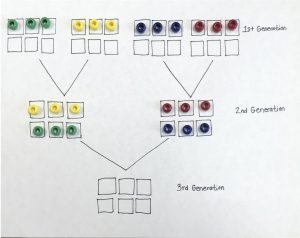 Pick two different colors, not yet used (i.e. your remaining two colors), to create the other set of individuals. Combine half of the beads from each individual of a set to create an individual for the 2nd generation. Do the same with the other set. Be careful not to mix between the sets.
Pick two different colors, not yet used (i.e. your remaining two colors), to create the other set of individuals. Combine half of the beads from each individual of a set to create an individual for the 2nd generation. Do the same with the other set. Be careful not to mix between the sets.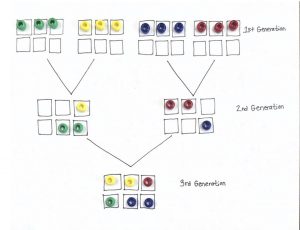 Now combine half of the beads from each individual in the 2nd generation to create an individual for the 3rd generation. Have youth close their eyes and pick 3 beads from the 2nd generation to create the 3rd generation individual.
Now combine half of the beads from each individual in the 2nd generation to create an individual for the 3rd generation. Have youth close their eyes and pick 3 beads from the 2nd generation to create the 3rd generation individual.
- “Are there any beads that made their way all the way from the 1st generation to the 3rd?”
- “Are there any beads that didn’t travel at all?”
- “Do you think all your templates look the same?” Youth can also share their templates here, even if it’s just the 3rd generation.
- “How does this relate to your life?” “What connections do you see to your own life?” “How might you use this information in the future?”
Explain
- Inheritance is something that gets passed down from generation to generation. Each of us gets half our characteristics from our biological mom and a half from our biological dad.
- Scientists use the word ‘inheritance’ when describing characteristics and information that gets inherited or passed down.
- Imagine the beads that were just used as characteristics. Some characteristics traveled through generations, others did not.
- The characteristics are determined by DNA. DNA stands for deoxyribonucleic acid. Your DNA is unique to you and is different from every other person in the world (unless you’re an identical twin). DNA is in every cell in our body, which means there are around 10 trillion of them. DNA tells each cell what it is (liver cell, skin cell, etc.) and what it’s supposed to do (your job is __). DNA stays the same throughout your entire life, it doesn’t change or grow as you grow older.
Elaborate
- Because DNA is in our cells, anything that has our cells contains DNA.
- Crime scene investigators can extract (take out) DNA from hair, dead skin, and saliva. It’s even in our scat.
- Let’s extract some DNA together (see ‘Strawberry extraction instructions ‘ in ‘Additional Resources’ for a PDF form of the instructions with pictures)! See directions below (starting at a).
- “Before we start. What do you predict will happen? What will the DNA look like?”. These predictions can be recorded on the whiteboard, prediction sheet included, or just discussed aloud.
- Share the directions of the extraction with the youth and let them lead you through the steps. Ask clarifying questions if needed.
- Take out the strawberries and pull off any green leaves
- Put the strawberries into the plastic bag and gently smash them with your hands for a couple of minutes until they are completely crushed. This helps break down the cells of the strawberry, releasing the DNA.
- In one of the plastic cups, create the liquid that will extract the DNA. Mix together 2 teaspoons of dish detergent, 1 teaspoon salt, and ½ cup of water.
- Add 2 teaspoons of the DNA extraction liquid to the bag of smashed strawberries.
- Seal the bag and gently smash for another minute. Try to avoid creating a lot of soap bubbles. This helps break open the cells even more.
- Place the coffee filter inside the other (clean) plastic cup.
- Pour the strawberry liquid into the filter. Squeeze out the remaining liquid from the filter.
- Start to pour the ½ cup of rubbing alcohol down the side of the cup that contains the strawberry liquid. Use as much rubbing alcohol as there is strawberry liquid (you may not use the whole ½ cup). Do not mix or stir. Have youth observe what happens next.
- Watch the cup, as a white substance should start to settle on the top of the strawberry liquid. This is the DNA!
- Using the coffee stirrer, tilt the cup of strawberry liquid and pick up some of the DNA.
- Show youth what the DNA looks like.
- “What did you observe?”
- “How do your predictions compare to your observations?”
- “What are your reactions?” “What are you thinking or feeling as you see this?”
- You (and youth) may be wondering how these activities relate to sustainable fishing or themselves. Share ‘No to fish fraud: How DNA testing ensures the authenticity of MSC labeled seafood’ video in Additional Resources (#6).
- After watching the video ask the youth “How is what we did like what scientists do?”
- Crime scene investigators and scientists extract DNA from plants, animals, and humans to track its inheritance and to determine what it is (who the person is or what animal/plant it’s from).
- “Did anyone notice in the video the scientist explaining how this is new, innovative technology?” “What do you think that means?”
- This means that we were not always able to identify species with DNA. Technology, just like science, changes and develops over time. As we continue to ask questions and test them we refine what we know and how the world around us works. Oftentimes this includes developing solutions, more sustainable practices, or improving lives.
- After watching the video ask the youth “How is what we did like what scientists do?”
Note for Facilitator: the charge and polarity of the alcohol solution penetrate the cell wall and that is why it’s able to extract DNA. If you (or youth!) are more interested in this, check out the article, ‘Role of alcohol in DNA extraction’ in Additional Resources.
Evaluate
Discuss the following questions as a whole group.
- “You observed and evaluated a scientific phenomenon. How would you communicate what you saw and learned?” “If someone asked you what DNA is, what would you tell them? What important things would you want to make sure you talk about?”
- “What about inheritance?”
- “Why was this activity important to you?”
Extension
- Allow youth to draw a picture of themselves, coloring it as accurately as possible.
- Have them notice their characteristics: eye color, hair color, curly or straight hair.
- Choose a few characteristics to survey as a group.
- Survey the youth and record the characteristics.
- “What can we infer about this data?”, “How could this data be helpful to us as scientists?”
Additional Resources:
- What is DNA and How Does it Work? (YouTube) — detailed description of DNA (the molecular structure, proteins, and chemistry behind it)
- Biometrics Activities: Create a DNA Fingerprint (STEM-Works website) — the introduction to the activity has a simplified explanation of DNA
- What are Traits? Basics of inheritance and traits (Learn.Genetics Genetic Science Learning Center website)
- Directions for strawberry DNA extraction: How to Extract DNA from a Strawberry (PDF) (National Human Genome Research Institute website)
- Role of Alcohol in DNA Extraction (Genetic Education/Learn Genetics website)
- No to fish fraud: How DNA testing ensures the authenticity of MSC labeled seafood (YouTube) (Marine Stewardship Council – Sustainable seafood)
Supported by National Science Foundation award #OIA-1849227 to
Maine EPSCoR at the University of Maine.

This project is part of the RII Track-1: Molecule to Ecosystem: Environmental DNA as a Nexus of Coastal Ecosystem Sustainability for Maine (Maine-eDNA) at the University of Maine.
